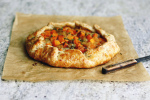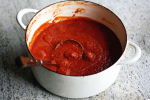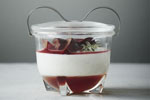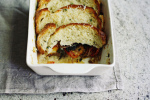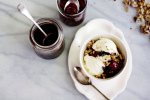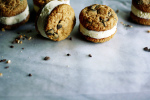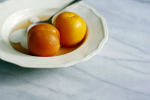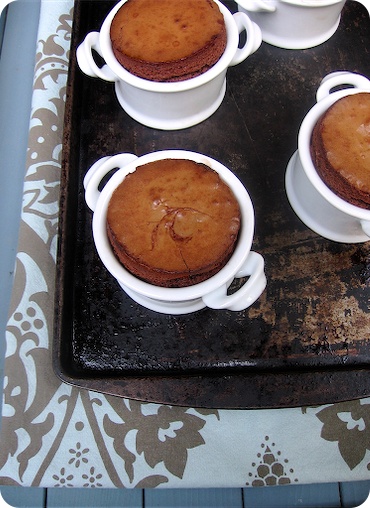An everyday sort of thing
 Thursday, January 24, 2008 at 2:01PM
Thursday, January 24, 2008 at 2:01PM 
I wish I could say that every dish I made had a fabulous backstory. Something compelling, or educational or even enticingly tempting. Heck, I would even settle for vaguely amusing sometimes. But sadly, that is not the case.
In truth, most of the dishes that reach our table do so out of a straightforward need to stop the grumbling of our bellies. And more often than not, there is an emotional whim attached.
Such was the case with the menus we have enjoyed this week. A bitterly cold spell and some particularly heavy workloads took their toll by Tuesday, by which time we found ourselves in need of sustenance of both the body and spirit. That afternoon I called my dear Mum, not only for a bit of cheer but also for her minestrone recipe - a dish I have not had for years.
Preparing it for Sean and Benjamin brought instant comfort. All it asked of me was some idle chopping, followed by lazy stirring now and again. Just the sort of demand I could handle. The pot gently simmered on the stove, filling the kitchen with a heady steam. A mere half-hour later we were rewarded with a hearty meal, all slurped up with a spoon. I had meant to take a photo but we were far too impatient to allow for such an interruption.
On Wednesday the mood continued, though we were buoyed by the meal the night before. In anticipation of another late evening for Sean I set about making one of his all-time, desert island desserts - a crumble. Without enough produce to make the preferred apple version, I nosed my way through our pantry to assemble this apple and mixed berry hybrid. The frozen berries, a direct violation of my commitment to eating seasonally, add a bit of brightness to a dreary month with their luxuriously velvet juices coating the apples beautifully.
My finished product was what I had hoped; a buttery crust that gave way to a filling more subtle in its sweetness than other versions, with just enough spice to add some resonant warmth. An offering that was everyday but just a bit special, and altogether satisfying.
I wish I could say that this dessert was ground-breakingly interesting, but it is not. It is simply familiar, uncomplicated and good. Sometimes, that is more than enough.
Apple and mixed berry crumble
My own recipe. As laziness is an integral part of comfort cooking, the version pictured used frozen berries and their juices; resulting in a luscious sort of fruit slump on the plate. If you prefer a less juicy version, defrost and drain the berries before adding to the filling.
Ingredients
1/2 pound cold butter (2 sticks), diced, plus more at room temperature for pan
2/3 cup blanched, sliced almonds
1/3 cup unsweetened flaked coconut
2/3 cup packed brown sugar
3/4 cup rolled oats
1/2 teaspoon salt
3/4 cup all purpose flour
1/2 cup whole wheat flour
1 1/2 pounds tart baking apples, preferably Granny Smith, peeled, cored and cut into medium dice
1 1/2 pounds frozen berry mix, see note above
Juice and zest of 1/2 lemon
2/3 cup granulated sugar
2 tablespoons cornstarch
1/8 teaspoon ground cinnamon
1/8 teaspoon ground cardamom
1/8 teaspoon ground ginger
Preheat oven to 375ºF (190ºC). Lightly butter a 9"x13" baking dish and place this on a parchment-lined baking sheet.
In a large bowl, or in the bowl of a stand mixer with a paddle attachment, combine almonds, coconut, brown sugar, 1/4 teaspoon salt, oats and flours. Using a pastry cutter, or the mixer on its lowest speed, cut in 1 3/4 sticks (14 tablespoons) butter into the dry ingredients. When finished the mixture should resemble a coarse, uneven meal. Set aside.
In a large bowl, combine apples, frozen berries, lemon zest, lemon juice, sugar, cornstarch, spices and remaining 1/4 teaspoon salt. Toss gently to combine well. Pour fruit mixture into prepared baking dish and dot with the reserved butter.
Sprinkle topping evenly over dish, leaving a bit of the fruit peaking out at edges. Bake for 55-60 minutes, until the filling is bubbling and the top is golden brown. Allow to stand 5-10 minutes before serving.
Recipe Notes:
• You may want to adjust the sugar depending on your taste and the sweetness of the fruit.
• The coconut is an addition I always enjoy for textural contrast, but is not essential.
• The spice measurements are an approximation of "one good pinch" of each. Again, adjust as you see fit.
Sidenote:
• I our house this is a crumble, but I do see that some would call it a crisp. What would call it?


